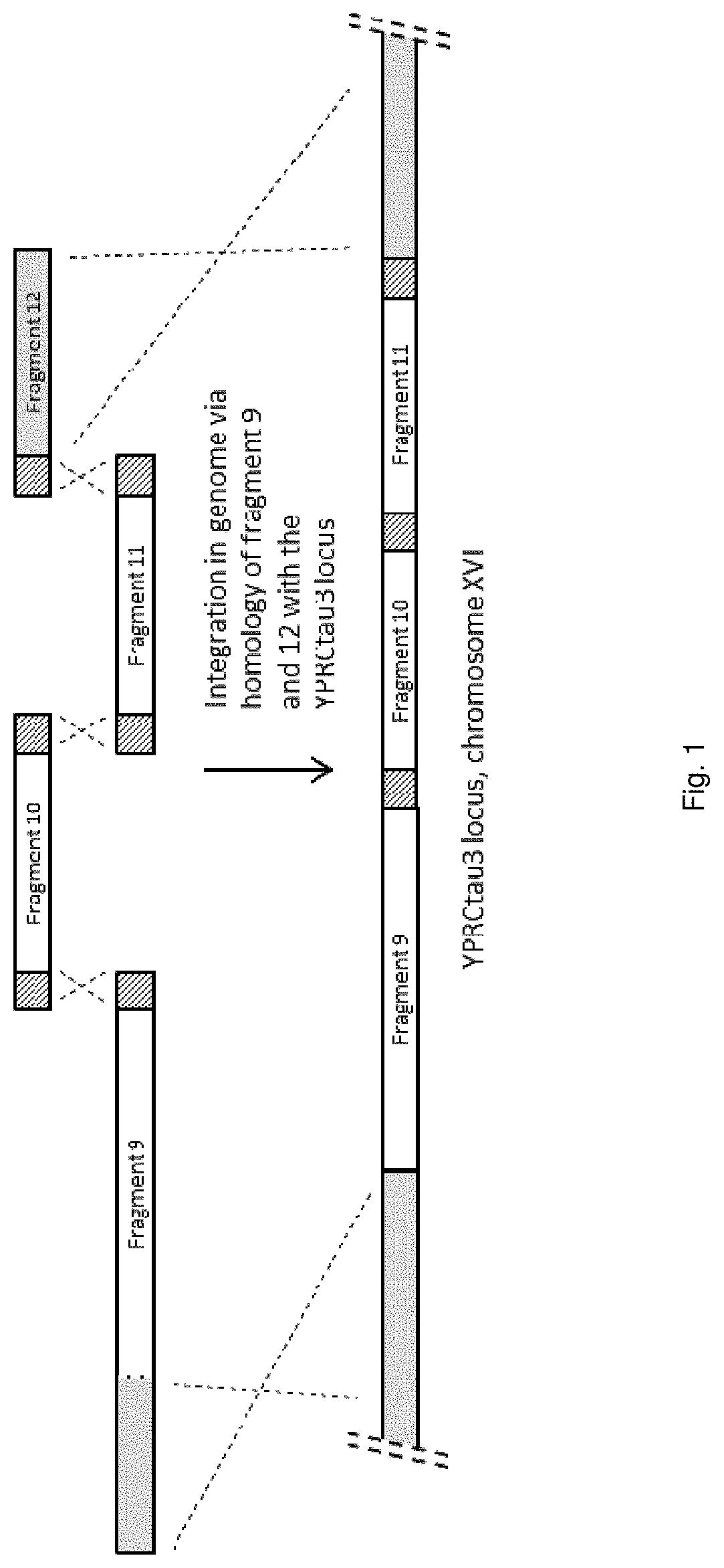Malate dehyrogenases
a technology of malate dehyrogenase and malate phosphate, which is applied in the field of recombinant host cells, can solve the problems of high cost and harmful processes for the environmen
- Summary
- Abstract
- Description
- Claims
- Application Information
AI Technical Summary
Problems solved by technology
Method used
Image
Examples
example 1
ion of Strain SUC-1029
[0253]Strain CEN.PK 113-7D (MATa HIS3 LEU2 TRP1 MAL2-8 SUC2) was used as a starting point to construct strain SUC-1029. A fumarase gene of Rhyzopus oryzae (FUMR) was transformed to strain CEN.PK113-7D as described below.
Generation of PCR Fragments
[0254]PCR fragment 9 was obtained by PCR amplification of SEQ ID NO: 34 using primers amplifying the entire nucleotide sequence of SEQ ID NO: 34. SEQ ID NO: 34 describes a synthetic polynucleotide containing the fumarase (FUMR) nucleotide sequence from Rhyzopus oryzae as disclosed in patent application WO2009 / 065779. The gene sequence was codon pair optimized for expression in S. cerevisiae as disclosed in patent application WO2008 / 000632. Expression of the FUMR gene is controlled by the TDH1 promoter (600 bp directly before the start codon of the TDH1 gene) and the TDH1 terminator (300 bp directly after the stop codon of the TDH1 gene). The TDH1 promoter and TDH1 terminator sequences controlling expression of FUMR are...
example 2
ion of Strain SUC-1112
Generation of PCR Fragments
[0263]Primer sequences described in SEQ ID NO: 9 and SEQ ID NO: 10 were used to generate PCR fragment 1 consisting of the 5′ INT59 integration site, using genomic DNA of strain Saccharomyces cerevisiae strain CEN.PK 113-7D (MATa HIS3 LEU2 TRP1 MAL2-8 SUC2) as template.
[0264]PCR fragment 2 was generated by using the primer sequences described in SEQ ID NO: 11 and SEQ ID NO: 12, using SEQ ID NO: 1 as template. SEQ ID NO: 1 encodes phosphoenolpyruvate carboxykinase (PCKa) from Actinobacillus succinogenes, as disclosed in patent application WO2009 / 065780. This synthetic sequence, which includes promoter-gene-terminator sequence, including appropriate restriction sites, was synthesized by DNA 2.0 (Menlo Park, Calif., USA). The gene sequence was codon pair optimized for expression in S. cerevisiae as disclosed in patent application WO2008 / 000632. The synthetic gene is under control of (or operable linked to) a promoter from S. cerevisiae, i...
example 3
ation of a Malate Dehydrogenase Gene to Strain SUC-1112 and Production of Malic Acid in Resulting Transformants
Generation of PCR Fragments
[0275]Primer sequences described in SEQ ID NO: 25 and SEQ ID NO: 26 were used to generate PCR fragment 13 consisting of the 5′ INT1 integration site, using genomic DNA of strain CEN.PK 113-7D as template.
[0276]PCR fragment 114 was generated by using the primer sequences described in SEQ ID NO: 43 and SEQ ID NO: 44, using SEQ ID NO: 42 as template. SEQ ID NO: 42 contains the ZWF1 gene, encoding Glucose-6-phosphate dehydrogenase (G6PD). This synthetic sequence, which includes promoter-gene-terminator sequence, including appropriate restriction sites, was synthesized by DNA 2.0 (Menlo Park, Calif., USA). The gene sequence was codon pair optimized for expression in S. cerevisiae as disclosed in patent application WO2008 / 000632. The synthetic gene is under control of (or operable linked to) a promoter from Kluyveromyces lactis, i.e. the promoter of ORF...
PUM
| Property | Measurement | Unit |
|---|---|---|
| concentration | aaaaa | aaaaa |
| concentration | aaaaa | aaaaa |
| volume | aaaaa | aaaaa |
Abstract
Description
Claims
Application Information
 Login to View More
Login to View More - R&D
- Intellectual Property
- Life Sciences
- Materials
- Tech Scout
- Unparalleled Data Quality
- Higher Quality Content
- 60% Fewer Hallucinations
Browse by: Latest US Patents, China's latest patents, Technical Efficacy Thesaurus, Application Domain, Technology Topic, Popular Technical Reports.
© 2025 PatSnap. All rights reserved.Legal|Privacy policy|Modern Slavery Act Transparency Statement|Sitemap|About US| Contact US: help@patsnap.com



